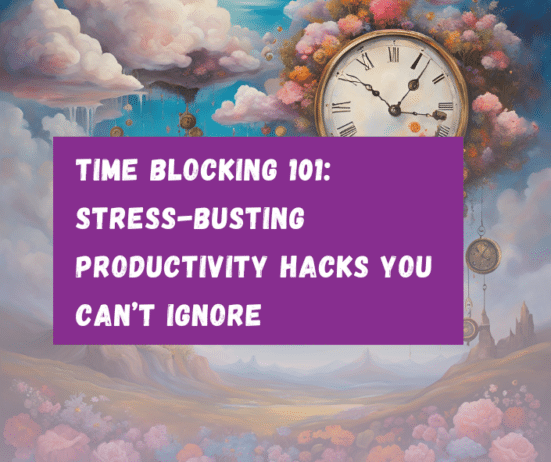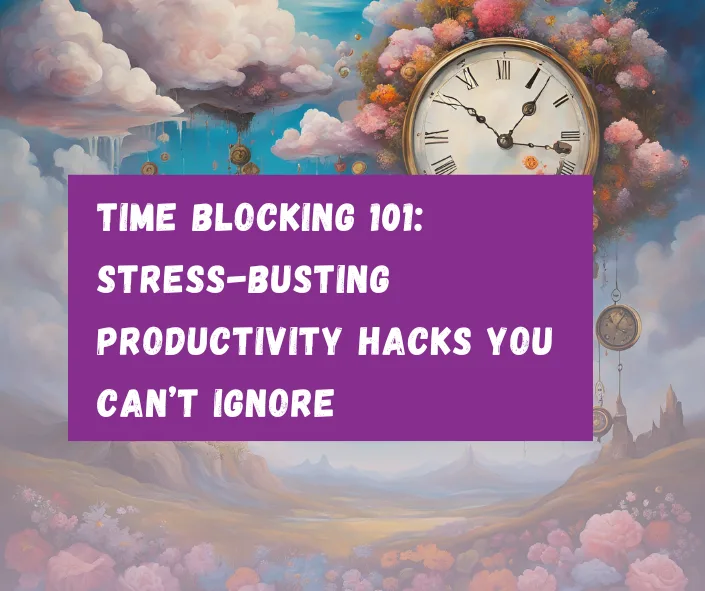February 24, 2025


You’re sitting at your desk, already five minutes late for a meeting, with emails piling up, deadlines looming, and your phone buzzing incessantly. You’re exhausted just thinking about how much there’s left to do, let alone how to actually get it all done. Sound familiar?
For many executives, navigating the high-pressure demands of leadership, this daily chaos is all too real.
The balancing act of excelling at work while maintaining a personal life often feels like an uphill battle.
Throw in the additional challenges of microaggressions, systemic bias, and workplace isolation, and stress can quickly spiral out of control.
But what if there were a way to take back control of your day and reduce that overwhelming sense of chaos? Enter time blocking: a game-changing tool for stress management that prioritizes clarity, focus, and balance.
The Challenges of Stress Management for Executives
High Expectations and Competing Priorities
As an executive, the stakes are high. Your role often comes with a long list of responsibilities, ranging from leading teams and managing projects to networking and making critical decisions. But for Black women in these roles, the stakes can feel even higher. Not only are you expected to excel in leadership, but you may also face unique challenges such as navigating microaggressions, breaking down systemic barriers, and often being “the only one” in the room.
Balancing these pressures with personal life can feel impossible. There’s never enough time in the day, and the constant juggling act often leads to feelings of burnout and exhaustion.
The Cost of Poor Time Management
When your days feel like one unending game of catch-up, it’s no surprise that stress levels skyrocket. Poor time management can lead to:
- Increased stress: You constantly feel behind, overwhelmed, or simply out of control in your life.
- Decreased productivity: Without clear priorities, energy is wasted on low-value tasks.
- Health impacts: Chronic stress increases your risk of physical and mental health issues, such as anxiety, insomnia, or even high blood pressure.
Fortunately, tools like time blocking can help you regain control, reduce stress, and create more balance in your life.
What Is Time Blocking?
Definition
Time blocking is a time management method that involves scheduling specific blocks of time for tasks or activities in advance. Instead of working from an overwhelming to-do list, you dedicate intentional time to specific priorities.
For example, rather than saying, “I’ll work on this report today,” you would schedule 9:00–10:30 AM as “Deep Work: Draft Report.” Or rather than saying, I’ll get to self-care when I have time. You would schedule something like, salt cave at the spa 3:45-5:00 PM. Each task has a set place in your day, helping you focus on one thing at a time.
How It Differs from a Traditional To-Do List
A traditional to-do list is reactive: you’re constantly shifting tasks around, hoping you’ll cross off everything by the end of the day. Time blocking, on the other hand, is proactive. It forces you to:
- Prioritize tasks ahead of time.
- Build structure into your day.
- Set boundaries around when certain tasks happen.
Why Time Blocking Works for Executives
Promotes Prioritization
Time blocking forces you to focus on what really matters. By scheduling your most important tasks during your peak productivity hours, you maximize efficiency and reduce decision fatigue.
For example, one of my clients, let’s call her Simone, was struggling to juggle her responsibilities as a VP while also mentoring younger women in her field. Her days felt chaotic, and she often didn’t have the energy to give her best to either role. Once she implemented time blocking, she scheduled two 90-minute “deep work” sessions each week for strategic planning and blocked out time every Friday afternoon for mentorship calls. By focusing on her priorities, she was able to reduce her stress. Which resulted in her showing up more fully in both areas.
Fosters Work-Life Balance
When you block out time for personal priorities, whether it’s a morning workout, date night, or Sunday afternoon relaxation, you create space for the things that matter outside of work. This is especially critical for Black women executives, who often find self-care slipping to the bottom of their to-do lists.
Time blocking allows you to reclaim your time and integrate self-care into your schedule. Instead of squeezing in “me time” when you’re already exhausted, you treat it as non-negotiable.
Minimizes Stress
One of the biggest contributors to stress is the feeling of not having enough time. Gay Hendricks, in his book The Big Leap, has a sentence in chapter 6 that states “you are where time comes from”. He calls it Einstein Time. That really helped me shift my mindset about time, and understand how I see time is what matters. With a new mindset about time and time blocking, you’ll know exactly how your day is mapped out, which reduces the mental load of constantly figuring out “what’s next.”
What Is the Day-Theming Time Blocking Method?
In addition to traditional time blocking, a less commonly discussed but highly effective method is Day-Theming.
What Is Day-Theming?
Day-Theming is a variation of time blocking where you dedicate entire days to specific themes or categories of work. Instead of switching between tasks and priorities throughout the day, you group similar tasks into a single day to maintain focus and reduce context-switching.
For example:
- Monday: Focus on team meetings and internal communication.
- Tuesday: Deep work on strategic projects.
- Wednesday: Networking, relationship-building, or mentoring calls.
- Thursday: Administrative work like reports, emails, and scheduling.
- Friday: Personal growth and reflection (e.g., learning, planning the next week).
Why It Works
Day-Theming is particularly effective for executives because it minimizes decision fatigue. You don’t have to mentally switch between tasks as often, which reduces stress and increases productivity. It also allows you to fully immerse yourself in one type of work, resulting in higher-quality outcomes.
How to Incorporate Day-Theming
- Audit your tasks: Identify recurring activities that can be grouped together.
- Assign themes: Choose a focus for each day that aligns with your priorities.
- Communicate boundaries: Let your team know which days are dedicated to specific types of work so they can respect your schedule.
One of my clients who implemented Day-Theming shared how transformational it was: “Having dedicated days for deep work and meetings has freed up so much mental energy. I no longer feel scattered, and I can approach each day with clarity.”
Step-by-Step Guide to Implement Time Blocking for Stress Management
1. Evaluate Your Current Schedule
Start with a time audit. Spend a few days tracking how you currently spend your time, both at work and at home. This will help you identify patterns, time-wasters, and areas where you could be more intentional.
2. Set Priorities
Break your responsibilities into categories:
- Work tasks: High-focus projects, team meetings, emails.
- Self-care: Exercise, therapy, mindfulness practices.
- Family and relationships: Time with loved ones, community involvement.
- Personal growth: Reading, learning, or pursuing hobbies.
Ask yourself: What absolutely needs to get done? What can be delegated or removed altogether?
3. Create Your Time Blocks
Using a digital tool like Google Calendar or a physical planner, start mapping out your day. Some key tips:
- Schedule high-focus tasks during your peak energy hours. Boosted Workflow has a great article about nine strategies to identify what your peak energy hours are.
- Include blocks for breaks, lunch, and recovery time.
- Leave buffer time for unexpected tasks or emergencies.
For example, a sample day might look like this:
- 8:00–8:30 AM: Morning routine (self-care, journaling).
- 8:30–9:30 AM: Team meeting.
- 9:30–11:00 AM: Deep work on a priority project.
- 11:00–11:30 AM: Break.
- 11:30 AM–1:00 PM: Client calls.
- 1:00–2:00 PM: Lunch and recharge.
- 2:00–3:30 PM: Administrative tasks.
4. Stick to Your Plan
Consistency is key. To make time blocking work, you need to honor the schedule you’ve set. This means saying no to tasks that don’t align with your priorities and being realistic about what you can accomplish in a day.
5. Review and Adjust
At the end of each week, evaluate how well your time blocks worked. Did you over-schedule? Did you leave enough time for self-care? Adjust as needed to find a rhythm that works for you.
Common Mistakes to Avoid with Time Blocking
- Over-scheduling: Leaving no wiggle room for unexpected events.
- Ignoring breaks: Downtime is essential for maintaining focus and reducing stress.
- Inconsistency: Using time blocking sporadically will reduce its effectiveness.
The Impact of Time Blocking on Stress Management
Let me share a story of my own. A few years ago, I was juggling my career in the federal government, running two businesses, and personal life, and it felt like I was failing at all three. When I discovered time blocking, everything shifted. By setting aside specific times for work, rest, and connection, I felt more in control of my day.
One of my clients described a similar transformation: “Before time blocking, I constantly felt behind. Now, I finish my workday knowing I made progress on the things that matter most. It’s like a weight has been lifted.”
Practical Tools and Apps for Time Blocking
Here are some tools to get started:
- Google Calendar: Easy-to-use, with color-coding and reminders.
- Notion: A robust tool for integrating time blocks with project management.
- TimeBloc: Simple app specifically designed for time blocking.
- Analog planners: Perfect for those who prefer a tactile, pen-and-paper approach.
Final Thoughts
Time blocking isn’t just a productivity hack. It’s a stress management strategy that can help executives in high-pressure roles, reclaim their time and prioritize what matters most. By intentionally structuring your day, you can create balance, minimize stress, and show up as your best self in both your personal and professional life.
Ready to take back control of your time? Start with a simple time audit by downloading our free 1-Week Time Audit Worksheet. Use it as a first step to finding out what your time is spent on. Or, schedule a V.I.P. Roadmap session with me to create a personalized strategy that works for your unique needs.
What’s your biggest challenge with time management? Drop a comment below. I’d love to hear your thoughts!


I’m an ICF Professional Certified Coach (PCC) and a certified executive coach for Twanna Carter Professional & Personal Coaching, LLC. I flubbed my first career transition from the military so badly, it took me the next 10+ years to build my confidence and recover. I know what it feels like to struggle with imposter syndrome and uncertainty about my leadership skills in the workplace. It’s why I am dedicated to empowering Black women. Helping them navigate career challenges and uncertainty by providing them with the tools and strategies they need to be successful. Schedule a V.I.P. Roadmap session today.
If you enjoyed this blog, please share it. If you’re feeling generous buy me a coffee.☕️
Curated Reading List
- Melaninated Magic: 180 Affirmations to Nurture Your Soul and Unleash Your Black Girl Joy by Twanna Carter, PhD
- Eat That Frog!: 21 Great Ways to Stop Procrastinating and Get More Done in Less, by Brian Tracy
- Sacred Rest: Recover Your Life, Renew Your Energy, Restore Your Sanity by Saundra Dalton-Smith, MD
- I’m Not Yelling: A Black Woman’s Guide to Navigating the Workplace (Successful Black Business Women), Elizabeth Leiba.
- Crucial Conversations: Tools for Talking When Stakes Are High by Kerry Patterson, Joseph Grenny, Ron McMillan, and Al Switzler.
- Influence: The Psychology of Persuasion by Robert B. Cialdini.
- How to Win Friends and Influence People by Dale Carnegie.
- Lean In: Women, Work, and the Will to Lead by Sheryl Sandberg.
- Dare to Lead by Brene Brown.
- The Memo, by Minda Harts.
- Atomic Habits: An Easy & Proven Way to Build Good Habits & Break Bad Ones, by James Clear
- Worthy: How to Believe You Are Enough and Transform Your Life, by Jamie Kern Lima
- 33 Tools to Remake Your Career by Paul Gabriel Dionne
Read my latest blogs…
- Why Career Uncertainty Silently Shrinks Earning Power of Black WomenUnderstanding Career Uncertainty in Modern Professional Life Career uncertainty isn’t just confusion about what to do next. It’s an emotional fog that… Read more: Why Career Uncertainty Silently Shrinks Earning Power of Black Women
- Why Black Women Fail at Career Pivots. Barriers and Pathways to SuccessThe Harsh Reality of Career Pivots for Black Women Right now, more than 300,000 Black women in the U.S. are out of… Read more: Why Black Women Fail at Career Pivots. Barriers and Pathways to Success
- 7 Powerful Strategies to Brand & Thrive After a Layoff A Stark Reality. Over 300,000 Black Women Have Been Laid Off More than 300,000 Black women have been laid off since President… Read more: 7 Powerful Strategies to Brand & Thrive After a Layoff
- Personal Branding for Black Women Who Are Invisible. A Transformative GuideThe Power of Personal Branding for Visibility Invisibility is exhausting and Black women know it better than anyone else.Every meeting, every boardroom,… Read more: Personal Branding for Black Women Who Are Invisible. A Transformative Guide
- The Worker Bee Trap for Black Women Executives. How Over-performance Keeps Us Invisible in Corporate AmericaWorker Bee. The Hidden Trap Behind “Hard Work Pays Off” Growing up, many of us were taught the same lesson: If you… Read more: The Worker Bee Trap for Black Women Executives. How Over-performance Keeps Us Invisible in Corporate America
- Why Storytelling is Your Secret Weapon for the C-SuiteWhy Women Executives Need Strategic Storytelling As women executives, we know how vital it is to shape our narrative and own our… Read more: Why Storytelling is Your Secret Weapon for the C-Suite
- 3 Branding Mistakes That Sabotage Successful Black Women LeadersWhy Personal Branding Matters More Than Ever Visibility Equals Value As a Black woman in leadership, your excellence is undeniable. But it… Read more: 3 Branding Mistakes That Sabotage Successful Black Women Leaders
- Executive Coaching for Black Women. Empowering Unstoppable SuccessWhy Executive Coaching Matters for Black Women In today’s fast-paced corporate world, executive coaching for Black women is more than a… Read more: Executive Coaching for Black Women. Empowering Unstoppable Success
- Build a Powerful Network They Say. But No One Tells You How! To build a powerful network is one of the most influential tools for professional and personal success, yet most people approach it… Read more: Build a Powerful Network They Say. But No One Tells You How!
- 12 Tips to Successfully Changing CareersChanging careers is no longer the rare, risky leap it once was. It’s becoming a normal part of professional life. Whether you’re… Read more: 12 Tips to Successfully Changing Careers
- Powerful Network Secrets: Build Influence FastSecrets Revealed How to Build a Powerful Network A powerful network is one of the most useful tools for professional and personal… Read more: Powerful Network Secrets: Build Influence Fast
- The ‘Soft Life’ Schedule: How I Rebuilt My Week Around Rest, Results, and RelationshipsOnce upon a grind, I believed that success was measured in sleepless nights, endless hustle, and a calendar packed so tight… Read more: The ‘Soft Life’ Schedule: How I Rebuilt My Week Around Rest, Results, and Relationships






![Black women executive using storytelling with her team; Why Storytelling is Your Secret Weapon for the C-Suite; find Black executive story; executive coaching for Black women; best Black executive coach NY, best executive career coach near Maryland; find Black executive coach near TX; hire personal branding consultant for black women executives, branding audit services for black female founders, branding strategy package for women of color in business, personal branding coach for black women leaders, fix my executive brand [for black women], rebranding agency for black women-led companies, LinkedIn profile rewrite service for black female executives, corporate headshot photographer specializing in black women professionals, speaker branding package for black women keynote speakers, employer branding consultant for diversity & inclusion,](https://twannacarter.com/wp-content/uploads/2025/08/Why-Storytelling-is-Your-Secret-Weapon-for-the-C-Suite_Twanna-Carter-150x150-png.webp)
![successful Black woman executive standing next to a desk; 3 Branding Mistakes that Sabotage Black Women_Twanna Carter; how to recover from a branding mistake as a black female executive, rebranding strategy after a business mistake black women, fixing a weak personal brand as a woman of color in leadership, managing online reputation for black women executives, how to position myself as an industry expert [black woman], overcoming invisibility as a black woman in corporate america; building authority and credibility as a black female leader; branding for black women who want board positions; how to communicate my value as a black woman executive, personal branding for black women seeking c-suite roles,](https://twannacarter.com/wp-content/uploads/2025/08/3-Branding-Mistakes-that-Sabotage-Black-Women_Twanna-Carter-150x150-png.webp)














+ show Comments
- Hide Comments
add a comment